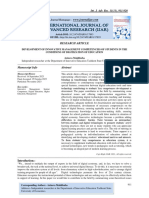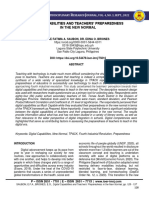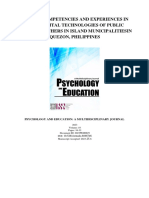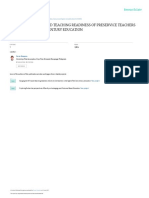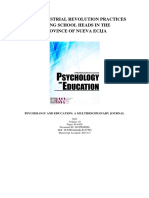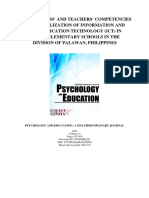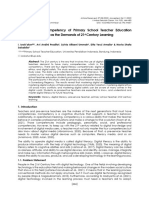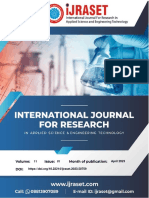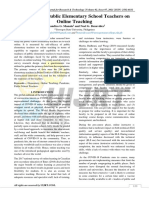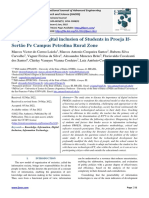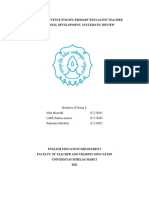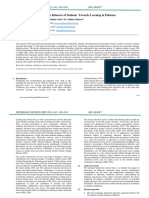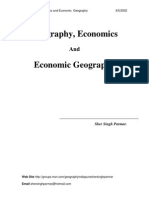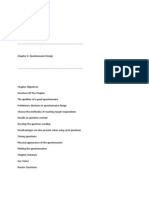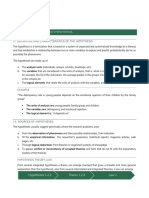Professional Documents
Culture Documents
Technical Training For School Teachers and Its Relationship To Future Trends Towards Digital Education in Palestine
Original Title
Copyright
Available Formats
Share this document
Did you find this document useful?
Is this content inappropriate?
Report this DocumentCopyright:
Available Formats
Technical Training For School Teachers and Its Relationship To Future Trends Towards Digital Education in Palestine
Copyright:
Available Formats
Volume 8, Issue 3, March – 2023 International Journal of Innovative Science and Research Technology
ISSN No:-2456-2165
Technical Training for School Teachers and its
Relationship to Future Trends Towards Digital
Education in Palestine
Abdelrahman Rateb Abdelrahman Shqair1 Prof. Madya Dr. Asma Abdul Rahman2
Dept. Universiti Sains Islam Malaysia City, Universiti Sains Islam Malaysia City,
Negeri Sembilan, Malaysia Negeri Sembilan, Malaysia
Dr. Muhammad Marwan Bin Ismail3
Universiti Sains Islam Malaysia City,
Negeri Sembilan, Malaysia
Abstract:- The study aimed to identify: "Technical I. INTRODUCTION
training for school teachers and its relationship to future
trends towards digital education in Palestine". A sample Future scientific competencies, on which the standard
of (30) male and female teachers from schools in the of development in different societies depends. The required
West Bank. The analysis was conducted using the change and the human element are considered one of its
statistical analysis program Spss. The study concluded most important components, and therefore constitute the
that there is a significant relationship between technical most prominent basic pillars for achieving this, in a way that
training and the orientation toward digital education in guarantees its continued preservation and development,
Palestinian schools, as the response rate on the first axis leading to excellence in achieving the set goals, as school
was 72% by individuals The sample and the second axis teachers represent the most vital and important element in
with an average score of (67.82) and with a large degree the field of school work.
for all axes amounted to (70.064), and the results showed
an average response on paragraphs (2-6) and the lowest Al-Sharif (2021), in his study "A proposed vision for
response rate on the second paragraph was about the developing the role of public school teachers in the southern
existence of applications that facilitate the training of governorates of Palestine in preparing their students for the
teachers on digital education, as the percentage reached information society," indicates the need to instruct the
The response was (62%), and the response to the Palestinian Ministry of Education to focus on the
paragraph related to preparing training efficiency was capabilities of teachers, and develop their technological
also moderate, as it amounted to (62.2%), and the practices in line with the requirements of the digital age,
presence of sufficient equipment for training inside the with the aim of achieving Educational goals. Al-Shammari
school amounted to (63%), and the results showed that (2019) indicates that the promotion of digital education in
weakness Incentives and work pressures affect technical schools needs a digital teacher who keeps pace with
training, which in turn is reflected in the trend towards developments in this era, which requires him to work hard
digital education. The results showed that the lack of and continuous effort.
technical applications in the Arabic language in training
reduces the motivation of teachers toward digital Problem Statement:
education. Based on the previous results, the researcher The international shift towards digital education
offers the following recommendations: The need to work imposed many challenges on educational institutions in the
on developing technical training mechanisms within Arab countries in general and Palestine in particular, the
clear methodologies and plans, taking into account the most important of which is the poor level of technical
work pressures of teachers and giving them sufficient training that teachers receive in the field of digital
space to benefit from technical training, the need to education. As a society, it has become imperative for the
follow up training with teachers and complete training state with all its institutions to play an active role in
programs, support training and provide incentives to inculcating the principles of information culture in education
trainees, the need to analyze training needs in the and application among these students, depending on
technical field and diversify training programs. qualified and technically trained teachers, and therefore the
need to integrate students with teacher preparation and
Keywords: Technical Training, School Teachers, Education training programs, and training and equipping the learner, as
Digital. well as with curricula and curricula education, educational
management programs, and so on, which is called for short
"the transition to digital education", since digital education
IJISRT23MAR1257 www.ijisrt.com 1115
Volume 8, Issue 3, March – 2023 International Journal of Innovative Science and Research Technology
ISSN No:-2456-2165
has become an important requirement, and an urgent spreading information awareness, and thus will contribute In
necessity for an era that the world has come to call the building informatics cadres that societies seek in the current
"digital age", which requires a change in the roles, tasks and era, after cognitive empowerment invaded various fields,
functions of the teacher, so that the teacher becomes a and educational institutions were not isolated from that
facilitator and advisor of information; By encouraging (Patton & Santos 2018) indicated that the promotion of
students to engage in various educational activities based on digital education in schools needs a teacher who is proficient
the various means of displaying educational activities in dealing with digital education strategies, and is convinced
offered by the Internet, away from stagnation, routine, and of the necessity of continuous education.
traditional systems in presenting activities, and exchanging
experiences related to educational activities. As for the study (2019, Dolfi), it was clear that digital
education requires education and training programs that
Based on the above, the study comes to answer the focus on communication skills, decision-making, self-
following question: What is the relationship between direction, leadership skills, teamwork skills, and continuous
technical training for teachers in Palestinian schools and self-learning that help maintain the impact of learning and
future trends toward digital education in Palestine? make the learning process more enjoyable.
This Study also Aims to: As for the study of Ali, Wael (2019), “the researcher
Exposing the relationship between technical training for indicated that the current era is called the era of revolution
teachers in Palestinian schools and the future orientation or (the digital age), as this era witnesses a revolution in the
toward digital education. production, manufacture, and innovation of digital
Identifying the training gaps of teachers in Palestinian technologies: the nanotechnology revolution, silicon chips,
schools and their relationship to the future orientation and mobile phone devices.”, fax machines, video cameras,
toward digital education. computers, means of communication and what they use of
To identify if there are statistically significant fiber optic technologies, satellites, information storage
differences at (α≤.05) for the role of technical training media, and networks around the world, especially the World
for teachers in Palestinian schools and the future Wide Web (the Internet). Employing this information
orientation towards digital education from the point of correctly, applying it, controlling it, and producing new
view of school teachers due to the following knowledge, which makes the learner bear the responsibility
demographic variables (sex, academic qualification, of his learning. Good employment is a basic requirement in
specialization, years of service, age, school place). all activities of daily life, especially in the field of teaching
and learning, and the research paper relied mainly on
Significance of the Study: previous studies. Ismail (2020), the most important updates
This research acquires importance due to the direct link of digital education in the Arab world through an original
between the technical training of Palestinian teachers in vision, in an attempt to face these challenges from an
finding future directions towards the application of digital intellectual standpoint closer to the Islamic roots and
education in Palestinian schools, with the aim of change, backgrounds of the Arab nation, especially since the
renewal, and modernity in the methods of teaching and variable of knowledge and digitization - as a contemporary
learning, and that creativity has become a goal sought by all reality characterized by modernity - imposes many
educational institutions to improve the quality of education challenges in various axes that require A transformation,
by raising the level of performance of the educational transformation, and addition in the formulation of
institution and creating a global competitive advantage by educational assets in this era, and the researcher used the
the standards of globalization and modern industrial inductive and deductive approaches because they are
revolutions. appropriate to the nature of the subject of the study. The
ethical axis There are challenges related to scientific
Previous Studies: integrity, evaluation, and some ethical controls in dealing
Among the studies that showed the importance of with digital education, which is revealed in the system of
training and the optimal use of digital educational Islamic values in the field of education, and in the material
technologies is the study of Al-Sharif (2018), which axis, the view must be comprehensive that accommodates
emphasized the importance of making use of and optimal the spiritual norms in Islamic law. The researcher
use of digital educational technologies in all stages of recommended facing and dealing with these challenges by
education, to provide theoretical and practical courses and adopting original visions based on the revelation of God
attention to planning, design and development of curricula Almighty. In the study of Markoun, Heba (2018), “Digital
and courses in the stages of education in a digital way to Education and the School of the Future,” the researcher
transform attitudes Education into digital, as Ahmed’s study indicates in her research paper that in light of the
(2018) showed, the importance of employing information developments that the world is witnessing today, the Arab
technology and the Internet in training and education, which learner must ask himself where his position is in the midst of
is considered one of the most important indicators towards these scientific and industrial revolutions. Traditional
the transformation of society into an information society, teaching methods are not compatible with modern life and
because this will contribute to increasing the efficiency and the thinking of the learner and teacher in the era of
effectiveness of education systems and teachers, and in technology and development. The researcher also points out
IJISRT23MAR1257 www.ijisrt.com 1116
Volume 8, Issue 3, March – 2023 International Journal of Innovative Science and Research Technology
ISSN No:-2456-2165
that traditional education at the present time did not add What distinguishes this study is that it came to link the
anything new to the educational content of generations practical experiences of the researcher in the field of digital
because it alone cannot keep pace with modern thought, and education to overcome the gap between theory and
the Arab world needs a shift in quantity and quality for application and to support and transfer the education process
learners of the twenty-first century, as the level of education from mere indoctrination by the teacher and the storage
is very low compared to global countries. This is not limited process by the student to the interactive dialogue process
to a few in particular, but it includes all countries in the and discussion between the two parties by focusing on the
region, so I found that the tendency to implement teacher as a main focus in the educational process. This
educational mechanisms that support traditional education, provides a supportive environment for creating a spirit of
such as digital education, has the ability to improve, support creativity and stimulates thinking and taking responsibility
and build a distinguished generation is one of the most for the learners, and the diversity of the topics raised and
important challenges that we must work on. As for the study their comprehensiveness, for essential topics in the field of
of Hamid, Suhair (2019), “Digital Education: A Conceptual transformation towards digital education, gives the current
and Theoretical Introduction,” the researcher indicates in her study its own characteristics and advantages.
research paper that the Arab world adopts traditional
teaching methods that are not compatible with modern life Currently, digital education technologies control
and the thinking of the student and teacher in the era of various political, economic, and social fields and their
technology and development. Also, traditional education at various aspects. This technology has been invested in
the present time did not add anything new to the educational facilitating and improving the learning and teaching process.
content of the generations because it alone cannot keep pace It has been gradually introduced into the educational process
with modern thought, just as the Arab world needs a shift in to stand side by side with the teacher and the book. This is
quantity and quality for the students of the twenty-first in order to contribute effectively to the delivery of
century, as the level of education is very low compared to knowledge to students easily and with high quality through
international countries, so I found that the tendency to the introduction of computers and their applications,
Implementing supportive educational mechanisms for including the World Wide Web, and electronic curricula, to
traditional education, such as digital education, that have the the educational process. It is achieved by technology from
ability to improve, support and build a distinguished devices, starting from the use of electronic display means to
generation is one of the most important challenges that we teach lessons in traditional classes, and the use of
must work on. multimedia in teaching and self-learning processes,
discussions, and open dialogues through technical means
Al-Sharif Bassem’s study (2018) showed the (Salim and Salih, 2020).
importance of measuring and determining the extent of
awareness of digital and smart educational technologies for Study Methodology and Procedures:
faculty members in Saudi universities and their attitudes In pursuit of the objectives of the study, the researcher
toward them.The research followed the descriptive will follow the analytical descriptive (quantitative)
approach, and used two research tools, namely: a approach, as it is the appropriate approach for this research,
questionnaire of the extent of awareness of faculty members due to its suitability to the nature and objectives of the
in Saudi universities about digital and smart educational research. A descriptive approach, it is also commensurate
technologies, and a measure of attitudes towards the use of with studies related to social and human studies, and the
digital educational technologies. Digital and smart in researcher's use of the analytical descriptive approach
education. The research sample was (15) faculty members describes the reality of cognitive empowerment of teachers,
from three Saudi universities. The current research has in addition to describing the level of progress in the field of
reached several results, the most important of which are: digital education in Palestinian schools, and by referring to
There are no statistically significant differences in the previous literature and what was published on the subject
degree of awareness of faculty members in Saudi during the past years In books, reports, periodicals, the
universities about educational technologies. digital and Internet, and official websites. The research will also
smart; is due to the main effect of the academic degree, or provide information and facts about the social phenomena
gender, and the results also found that there are statistically associated with the study community and the methods and
significant differences in the attitudes of faculty members in methods of quantitative statistical analysis to analyze the
Saudi universities due to the main effect of the academic study data, because quantitative research is able to develop
degree, while there were no statistically significant theories and models and accurately answer the study
differences in the attitudes also due to the primary effect of questions, to achieve the goals, and verify the hypotheses.
the gender factor for the members of the research sample. The use of statistical analysis in the quantitative
The research also made several recommendations, including methodology with high reliability, being more appropriate to
the need to make optimal use of digital educational the nature of the study, and the ability of quantitative
technologies in the university and pre-university education methods to validate the study hypotheses and verify the
stages in providing theoretical and practical courses. correlations within the study variables.
IJISRT23MAR1257 www.ijisrt.com 1117
Volume 8, Issue 3, March – 2023 International Journal of Innovative Science and Research Technology
ISSN No:-2456-2165
Study Population: technical training scale and the orientation scale towards
The study population consisted of 150 male and female digital education in order to formulate the questionnaire
teachers in schools in the central West Bank in Palestine and paragraphs in line with the scientific research literature.
and they have advanced technical training.
Tool validity
Study Sample: To ensure the validity of the tool, the researcher
The study sample included 30 teachers and teachers presented the study tool to (7) arbitrators specialized in the
and the sample was selected intentionally and based on the fields of education and the Arabic language, and the opinion
recommendations of their managers. of the majority was taken into account. As for the validity of
the internal consistency of the tool, this was done by
Field study: calculating the correlation coefficients for each paragraph in
The researcher chose an intentional sample consisting its domain, which shows the tables for calculating the
of (30) male and female teachers from public schools in the correlation coefficient for all the correlations of the
northern Palestinian governorates, who have received paragraphs.
advanced training in the field of technical training, in order
to identify the relationship between technical training and The stability coefficient was extracted using the
the future orientation toward digital education in the Cronbach alpha equation, where the total stability was more
Palestinian public schools in the West Bank (provinces). than (0.91), which is a strong stability coefficient, which
North), the researcher built the research tool - the makes the tool suitable for scientific research purposes. It's
questionnaire - based on the relevant literature and previous connected to the results.
studies directly related to the subject, and based on the
Study Variables:
Table 1 Shows the Distribution of the Sample, According to the Demographic Variables of the Study
Demographic variables Level Repetition Percentage %
Sex Male 13 43
Female 17 57
Age Less than 25 years 2 6,7
25-Less than 35 years old 6 20,0
45-35years old 13 43,3
Older than 45 years 9 30,0
Bachelor 16 53,3
Degree Higher Diploma 2 6،7
Master 12 40,0
Specialization scientific 14 7.46
Literary 16 3.53
Years of service Less than 5 years 7 23,3
5-less than 15 years 9 30,0
15years and above 14 46,7
Total 30 %100
II. RESULTS OF THE STUDY In Order to Interpret the Results, the Following
Approved Arithmetic Averages Were Adopted for the
This study aimed to identify: "Technical training for Response to the Items as Follows:
school teachers and its relationship to future trends towards (80%) or more is a very large impact score.
digital education in Palestine". )from 70% - 79.99%) a significant degree of impact.
(from 60%-69.99%) medium effect.
Results Related to the Main Question of the Study: (from 50%-59.99%), the degree of impact is small.
It states the following: What is the relationship (less than 50%) very low impact score.
between technical training for teachers in Palestinian
schools and future directions toward digital education in
Palestine?
To answer the question, the researcher used the
arithmetic averages for each paragraph and the total score of
the tool for the sample, and Table (2) shows that.
IJISRT23MAR1257 www.ijisrt.com 1118
Volume 8, Issue 3, March – 2023 International Journal of Innovative Science and Research Technology
ISSN No:-2456-2165
Table 2 Arithmetic Averages and Degree of Impact of Paragraphs and the Total Degree of Technical Training for School Teachers
and its Relationship to Future Trends Towards Digital Education in Palestine.
No. Paragraphs Standard Deviation Average Response Response %
Area I: Technical Training
There is a training plan for teachers on modern
1 0.87 3.87 77.3
technologies to promote digital education.
There are applications that facilitate the training
2 1.43 3.32 62
of teachers on digital education.
There is continuous technical training for
3 teachers according to the modernity of technical 1.33 3.39 67
educational programs.
There are sufficient equipment for technical
4 1.31 3.21 63
training within the school.
Teachers are involved in internal programs to
5 keep pace with the development of modern 1.26 3.14 63.6
technologies in teaching.
Reports are prepared on the efficiency of
6 1.00 3.05 62.2
technical trainings for teachers in schools
The school has technicians specialized in
7 0.84 4.49 88.2
technical educational programs
The number of halls is sufficient to implement
8 0.90 4.40 89.0
technical training in the school
School principals follow up on the results of
9 0.75 4.45 87.5
technical training for teachers
Principals encourage teachers to conduct
10 1.12 3.11 62.5
technical training in schools
The total score of the first 1.08 3.64 72.0
Future Trends Towards Digital Education.
Teachers' teaching load reduces their motivation
11 0.96 3.55 71.1
towards digital education training.
The great effort required to prepare digital
12 educational content reduces teachers' motivation 1.08 3.47 69.3
towards training in digital education.
The lack of obligation for teachers to train from
13 the school leadership reduces their motivation to 0.78 3.14 67.5
use digital education.
The difficulty of applying digital education in
some practical subjects reduces teachers'
14 0.78 3.75 75.3
motivation towards training and digital
education.
The lack of technical applications in Arabic in
15 training reduces teachers' motivation towards 0.87 3.14 60.7
digital education.
Promotes the provision of incentives technical
16 training and orientation towards digital 0.73 3.12 65.8
education
Teachers' lack of conviction in the importance of
17 training reduces motivation to move towards 1.06 3.45 69.1
digital education.
The need for continuous training reduces
18 1.11 3.14 62.7
teachers' motivation towards digital education
Too many students reduce teachers' motivation
19 0.98 3.54 59.5
towards training in digital education in schools.
Lack of training capabilities reduces teachers'
20 0.88 3.25 77.3
orientation towards digital education
The total score of the second field 0.921 3.354 67.82
The overall score of all paragraphs of the tool 1.001 3.494 70.064
* Maximum response score (4) degrees.
IJISRT23MAR1257 www.ijisrt.com 1119
Volume 8, Issue 3, March – 2023 International Journal of Innovative Science and Research Technology
ISSN No:-2456-2165
First: Results of the First Field: The second hypothesis was also examined using Single
It appears from the previous table (2) that the response Variance Analysis (ANOVA) to extract the significance of
to the eighth paragraph was large and amounted to (89.0), it the differences on the total score of the instrument according
was medium to paragraphs 2-6 and the tenth paragraph and to the variable of scientific qualification at the sample,
it amounted to (2.63), and it was very large to paragraphs Results of Single Variance Analysis (ANOVA) to extract
(7,8,9) and the average response was It was approved by the the significance of differences on the total degree of the
sample (88.8), and the average response was great on all instrument according to the variable of academic
paragraphs of the first field, amounting to (72.0). qualification at the sample.
Second: Results of the Second Field: Orientation * Statistically D at (≤0.05). shows that there are no
Towards Digital Education: statistically significant differences at the level of
It appears from the previous table (2) that the average significance ((≤ 0.05) on the total degree of the tool
response is large in paragraphs (11, 14, 20), and the average according to the variable of scientific qualification, and
response to it by the sample was between (4, 75), and the therefore the first hypothesis was accepted in the current
response was medium in paragraphs (12, 13, 15, 16, 17, 18) study.
The average response to it by the sample ranged between
(65.85). The response was low in paragraph (19) and the Results Related to the Third Hypothesis:
average response to it was (59.5). The response rate on the The third hypothesis states the following: "There are
total score for all paragraphs of the second field was no statistically significant differences at the level of (α≤
medium and amounted to (67.82%), while the average 0.05) for technical training for school teachers and its
response on all paragraphs was large and amounted to relationship to future trends towards digital education in
70,064. Regarding trends toward digital education, this Palestine, attributed to the variable of years of service To
shows the seriousness of dealing with the issue of digital examine the third hypothesis, the researcher used the
education in Palestinian schools. arithmetic averages of the total score of the tool according to
the variable of years of service. As shown Arithmetic
Results of the Study Hypotheses: Averages of the Total Score of the Instrument by Years of
Service Variable.
Results Related to the First Hypothesis:
The first hypothesis states the following: "There are no The third hypothesis was also examined using Single
statistically significant differences at the level (α ≤ 0.05) for Variance Analysis (ANOVA) to extract the significance of
technical training for school teachers and its relationship to differences on the total score of the instrument according to
future trends towards digital education in Palestine, due to the sample years of service variable. Results of Single
the gender variable. Variance Analysis (ANOVA) to extract the significance of
the differences on the total degree of the instrument
To test the first hypothesis, the researcher used the T- according to the variable of years of service at the sample.
test for two independent groups to indicate the differences in
the total score of the tool according to the gender variable. * Statistically shows that there were no statistically
significant differences at the level of significance ((≤ 0.05)
The results of the (t) test for two independent groups on the total score of the tool according to the variable of
indicate differences in the total score of the tool according to years of service. Thus, the third hypothesis was accepted in
the gender variable. the present study. Results related to the fourth hypothesis:
The fourth hypothesis states the following: "There are no
* Statistically D at (≤0.05). It is clear from the statistically significant differences at the level of (α≤ 0.05)
previous that there were no statistically significant for the role of the security institution in preserving cultural
differences at the level of significance (α≤ 0.05) on the total heritage and tourism security is due to the variable of
score of the tool according to the gender variable. Thus, the scientific qualification to examine the fourth hypothesis. As
first hypothesis was accepted for the sample in this study. shown Results of (T) test for two independent groups to
indicate differences in the total score of the instrument
Results Related to the Second Hypothesis: according to the gender variable
The second hypothesis states the following: "There are
no statistically significant differences at the level of (α≤ * Statistically D at (≤0.05). It is clear from the previous
0.05) attributed to the variable of scientific qualification. To that there are no statistically significant differences at the
examine the hypothesis, the researcher used the arithmetic level of significance (α≤ 0.05) on the total score of the tool
averages of the total score of the tool according to the according to the variable of academic qualification. Thus,
variable of scientific qualification. As shown Arithmetic the fourth hypothesis was accepted for the sample in this
averages of the total score of the instrument according to the study.
variable of academic qualification.
IJISRT23MAR1257 www.ijisrt.com 1120
Volume 8, Issue 3, March – 2023 International Journal of Innovative Science and Research Technology
ISSN No:-2456-2165
III. DISCUSSION OF THE RESULTS [7]. Al-Hilali, Al-Sherbiny (2020). "Digital Teaching and
Learning", a speech by Prof. Dr. El-Hilali El-
The results also showed an average response in Sherbiny El-Hilali. Technology Journal 1(1), 3-9.
paragraphs (2-6), and the lowest response rate was in [8]. Al-Hassan Essam Idris (2006), a study on the
the second paragraph about the existence of applications development of the performance of a university
that facilitate teacher training on digital education, as faculty member in the framework of integration
the response rate reached (62%). between educational, analogue and digital
The response to the paragraph related to preparing technology. Arar Library.
training efficiency was also moderate, amounting to [9]. Salim, Heba and Salih, Yaman (2020), “Challenges
(62.2%), and the presence of sufficient equipment for of Distance Learning in Light of the Corona
training within the school amounted to (63%). Pandemic: “An-Najah National University as a
The results showed that weak incentives and work Model”, study, published, Journal of the College of
pressures affect technical training, which in turn is Educational Sciences, An-Najah Virtual University,
reflected in the trend toward digital education. The Nablus-Palestine.
results showed that the lack of technical applications in [10]. Al-Sharif, Hamdi (2021). A proposed vision to
the Arabic language in training reduces teachers' establish an enabling environment for the success and
motivation toward digital education. sustainability of digital transformation in education
in light of Egypt's digital vision. The Educational
RECOMMENDATIONS Journal of the Faculty of Education in Sohag, 91
(91).
Based on the Previous Results, the Researcher Makes [11]. Ali, Wael Abdullah Muhammad, (2019) Teaching
the Following Recommendations: and learning mathematics in the digital age, (The
The need to work on developing technical training Arab Foundation for Education, Science and Arts,).
mechanisms within clear methodologies and plans. Dolfi, Tom. (2019): What Is The Future Of
Taking into account the work pressures of teachers and Education? 23 Experts Share Their Insights,
giving them enough space to benefit from technical https://www.disruptordaily.com/share-your-insights.
training. [12]. Patton Renee & Santos Richard (2018): The next
The need to follow up on the training of teachers and generatin digitl Learning environment and Aframe
complete the training programs. work for change for educations institutions Cisco
Supporting training and providing incentives to trainees and/ or its affiliates available at
The necessity of analyzing training needs in the technical
field and diversifying training programs.
REFERENCES
[1]. Abraham, Michael. 2022. “Data Analysis Course.”
Educational lectures. April 2022.
[2]. Ahmed, Ismail Othman Hassan (2020), Challenges of
digital education in the Arab world: an original
vision, (The Arab Journal of Specific Education.
[3]. Ahmed, Daoud (2018), "Technological Challenges
for Education in the Arab World", a published study,
Journal of the Department of Legal and Political
Research and Studies, Issue (5), Algeria.
[4]. Al-Shammari, Thani Hussein (2019): The Role of
Digital Learning in the Professional Development of
Teachers, Arab Journal of Educational and
Psychological Sciences, National Research Center:
Gaza, Palestine, Issue (7), February, pp. 25-42.
[5]. Al-Sharif, Muhammad (2018), “The extent of
awareness of digital and smart educational
technologies among faculty members in Saudi
universities and their attitudes towards them, Part 37,
P. 179 (Journal of the College of Education, Al-
Azhar University, Egypt).
[6]. Al-Sharif, Huda (2021). The efficiency of physics
teachers' use of smart classrooms in the virtual
environment and its relationship to their digital skills.
Journal of the Faculty of Education (Assiut), 37 (11),
405-464. ISO 690.
IJISRT23MAR1257 www.ijisrt.com 1121
You might also like
- Blending Pedagogy and Digital Technology To TransfDocument9 pagesBlending Pedagogy and Digital Technology To TransfDanielMuñozNo ratings yet
- Development of Innovative Management Competencies of Students in The Conditions of Digitization of EducationDocument10 pagesDevelopment of Innovative Management Competencies of Students in The Conditions of Digitization of EducationIJAR JOURNALNo ratings yet
- Sustainability 12 05339 v3Document14 pagesSustainability 12 05339 v3Judy Lee CalisoNo ratings yet
- Big Data Analysis and Modeling of Higher Education ReformDocument11 pagesBig Data Analysis and Modeling of Higher Education ReformsimranNo ratings yet
- Theinfluence of Digital Literacy Skill On Academic PerformanceDocument11 pagesTheinfluence of Digital Literacy Skill On Academic PerformanceHihezzzNo ratings yet
- Content and Educational Resources of The Development of Digital Competence in Students of Pedagogical Higher Educational InstitutionsDocument7 pagesContent and Educational Resources of The Development of Digital Competence in Students of Pedagogical Higher Educational InstitutionsResearch ParkNo ratings yet
- Digital Capabilities and Teachers' Preparedness in The New NormalDocument10 pagesDigital Capabilities and Teachers' Preparedness in The New NormalIOER International Multidisciplinary Research Journal ( IIMRJ)No ratings yet
- Making Math Fun and Engaging Via The Use of Modern Technology Capacity Building For Mathematics TeachersDocument10 pagesMaking Math Fun and Engaging Via The Use of Modern Technology Capacity Building For Mathematics TeachersIOER International Multidisciplinary Research Journal ( IIMRJ)No ratings yet
- From Digital Literacy To Digital Competence - The Teacher Digital Competency (TDC) FrameworkDocument24 pagesFrom Digital Literacy To Digital Competence - The Teacher Digital Competency (TDC) FrameworkhakeemNo ratings yet
- Developing teachers digital identity towards the pedagogic design principles of digital environments to enhance students learning in the 21st centuDocument20 pagesDeveloping teachers digital identity towards the pedagogic design principles of digital environments to enhance students learning in the 21st centuRUBY HARIS 22.55.2334No ratings yet
- Group 3 PPT (Final)Document44 pagesGroup 3 PPT (Final)lynx.lynx11022007No ratings yet
- 21 ST Century Education ArticleDocument8 pages21 ST Century Education ArticleSharvini SharuNo ratings yet
- Literature Review Group 3 Critical ReviewDocument10 pagesLiterature Review Group 3 Critical Reviewp132681No ratings yet
- ED616121Document16 pagesED616121LyN-naejFernandezNo ratings yet
- FABULAR-GROUP Chapter-123Document20 pagesFABULAR-GROUP Chapter-123MARITES M. CUYOSNo ratings yet
- LIS 2022 New 1-106-115Document10 pagesLIS 2022 New 1-106-115Lppm Politeknik JambiNo ratings yet
- Digital Competencies and Experiences in Using Digital Technologies of Public School Teachers in Island Municipalities in Quezon, PhilippinesDocument19 pagesDigital Competencies and Experiences in Using Digital Technologies of Public School Teachers in Island Municipalities in Quezon, PhilippinesPsychology and Education: A Multidisciplinary JournalNo ratings yet
- Gauging The Ict-Based Teaching Readiness of PreserDocument21 pagesGauging The Ict-Based Teaching Readiness of Preseryssay beauNo ratings yet
- Third Industrial Revolution Practices Among School Heads in The Province of Nueva EcijaDocument14 pagesThird Industrial Revolution Practices Among School Heads in The Province of Nueva EcijaPsychology and Education: A Multidisciplinary JournalNo ratings yet
- Modern Trends in Continuous Professional Development in The Nigerian Educational SectorDocument8 pagesModern Trends in Continuous Professional Development in The Nigerian Educational SectorResearch ParkNo ratings yet
- Role of Technology in Modern Teaching and Learning Effectiveness of Ict Integration in School Education - June - 2023 - 5071517658 - 8012695Document4 pagesRole of Technology in Modern Teaching and Learning Effectiveness of Ict Integration in School Education - June - 2023 - 5071517658 - 8012695shahidafzalsyedNo ratings yet
- Mr. TAHMASEBI's Proposal - MainDocument27 pagesMr. TAHMASEBI's Proposal - MainSaeid TahmasebiNo ratings yet
- School Heads' and Teachers' Competencies in The Utilization of Information and Communication Technology (ICT) in Public Elementary Schools in The Division of Palawan, PhilippinesDocument14 pagesSchool Heads' and Teachers' Competencies in The Utilization of Information and Communication Technology (ICT) in Public Elementary Schools in The Division of Palawan, PhilippinesPsychology and Education: A Multidisciplinary JournalNo ratings yet
- The Roles of Technology Literacy and Technology Integration To Improve Students' Teaching CompetenciesDocument14 pagesThe Roles of Technology Literacy and Technology Integration To Improve Students' Teaching Competenciesjudy ann naluzNo ratings yet
- Blended Learning Education: The Effectiveness of New Ways of Teaching and Learning in Enhancing Students' Academic AchievementDocument9 pagesBlended Learning Education: The Effectiveness of New Ways of Teaching and Learning in Enhancing Students' Academic AchievementPsychology and Education: A Multidisciplinary JournalNo ratings yet
- RRL FinalsDocument6 pagesRRL FinalsJohn SesconNo ratings yet
- Sang Et Al. (2023) - Digital Competence - InstrumentsDocument17 pagesSang Et Al. (2023) - Digital Competence - InstrumentsNur Dania Mohd RosliNo ratings yet
- The Use of Addie Model For Designing Blended Learning Application at Vocational Colleges in MalaysiaDocument14 pagesThe Use of Addie Model For Designing Blended Learning Application at Vocational Colleges in Malaysiafender 87No ratings yet
- The Scientific Journal of King Faisal UniversityDocument5 pagesThe Scientific Journal of King Faisal Universitym. Hashim IqbalNo ratings yet
- Digital Literacy of Teachers Within Covid-19Document12 pagesDigital Literacy of Teachers Within Covid-19Mark Luke TagnipezNo ratings yet
- The Integration of Technology in Education for Global Awareness - Unit 7 Written Assignment (EDUC 5810)Document6 pagesThe Integration of Technology in Education for Global Awareness - Unit 7 Written Assignment (EDUC 5810)tobi.igbayiloyeNo ratings yet
- Group11 Project ProposalDocument6 pagesGroup11 Project ProposalRave VillanuevaNo ratings yet
- Reading 1Document18 pagesReading 1PremiumJ4UShopMY245No ratings yet
- Revise ICT Proposal 2.3Document25 pagesRevise ICT Proposal 2.3Noel Delos AngelesNo ratings yet
- Sustainability 13 00582 v2Document16 pagesSustainability 13 00582 v2Zeo LycanNo ratings yet
- Chapters 1 5 in Format Checked by The GrammarianDocument66 pagesChapters 1 5 in Format Checked by The GrammarianJohn Eric RosalesNo ratings yet
- Forum On Future of Education Discusses Digital Transformation THAILANDDocument23 pagesForum On Future of Education Discusses Digital Transformation THAILANDnizamNo ratings yet
- Digital Pedagogy For Sustainable LearningDocument7 pagesDigital Pedagogy For Sustainable LearningchandiliongNo ratings yet
- Research Edtech Group ADocument19 pagesResearch Edtech Group ACARAGA MERRY ANN G.No ratings yet
- 10 11648 J Ijsedu 20221003 12Document7 pages10 11648 J Ijsedu 20221003 12Viola KierNo ratings yet
- Impact of Pandemic COVID-19 To The Online LearningDocument9 pagesImpact of Pandemic COVID-19 To The Online LearningHemaLin Nhema HemawathyNo ratings yet
- A Study On Digitalization in Education SectorDocument2 pagesA Study On Digitalization in Education SectorEditor IJTSRDNo ratings yet
- ### - Impact Assessment of Information and CommunicationDocument13 pages### - Impact Assessment of Information and Communicationnitishdr1231No ratings yet
- Digital Learning Is An Educational Format Towards Sustainable EducationDocument17 pagesDigital Learning Is An Educational Format Towards Sustainable EducationMahamud AliNo ratings yet
- ICT Implementation in Colleges of Education A FramDocument23 pagesICT Implementation in Colleges of Education A FramJames IloriNo ratings yet
- Impact of Digitalization on Distance EducationDocument4 pagesImpact of Digitalization on Distance EducationRai KageNo ratings yet
- Catañeda Beyond-Functionality-Building-Critical-Digital-Teaching-Competence-Among-Future-Primary-Education-12599Document17 pagesCatañeda Beyond-Functionality-Building-Critical-Digital-Teaching-Competence-Among-Future-Primary-Education-12599pacoperez2008No ratings yet
- Paradigm Shift of Digital Education Systems in Indian Education IndustryDocument16 pagesParadigm Shift of Digital Education Systems in Indian Education IndustryIJRASETPublicationsNo ratings yet
- Readiness of Public Elementary School TeDocument10 pagesReadiness of Public Elementary School TeFernnadico G. ManaloNo ratings yet
- MAS (2018) The Use of TechnologyDocument8 pagesMAS (2018) The Use of TechnologyTahreena ReenaNo ratings yet
- Descriptive Analysis of An Academic Article On The Topic "IT in Education"Document11 pagesDescriptive Analysis of An Academic Article On The Topic "IT in Education"araymrtvNo ratings yet
- Importance of Digital Inclusion of Students in Proeja If-Sertão Pe Campus Petrolina Rural ZoneDocument11 pagesImportance of Digital Inclusion of Students in Proeja If-Sertão Pe Campus Petrolina Rural ZoneIJAERS JOURNALNo ratings yet
- Digital Competence For Efl Primary Education Teacher Professional Development. Systematic ReviewDocument28 pagesDigital Competence For Efl Primary Education Teacher Professional Development. Systematic ReviewLuthfi Rahma AnnisaNo ratings yet
- Use of Information and Communication Technology in Enhancing Teaching and LearningDocument4 pagesUse of Information and Communication Technology in Enhancing Teaching and LearningImno TenshiNo ratings yet
- Review of Related Literature and StudiesDocument18 pagesReview of Related Literature and StudiesChiqui zantua-torresNo ratings yet
- Time To Transform Challenges and Opportunities For Teaching Practice During COVID 19 and BeyondDocument22 pagesTime To Transform Challenges and Opportunities For Teaching Practice During COVID 19 and BeyondJoanna MarieNo ratings yet
- Malzoubi,+882 Author+Article 268 1 6 20211008Document12 pagesMalzoubi,+882 Author+Article 268 1 6 20211008Maria Genevieve F. RedullaNo ratings yet
- 3613-Article Text-6784-1-10-20210310Document24 pages3613-Article Text-6784-1-10-20210310sambayanan26No ratings yet
- Probing Ict Competency of Student-Teachers in Region 10: Basis For Software Input DevelopmentDocument21 pagesProbing Ict Competency of Student-Teachers in Region 10: Basis For Software Input DevelopmentJojames GaddiNo ratings yet
- An Analysis on Mental Health Issues among IndividualsDocument6 pagesAn Analysis on Mental Health Issues among IndividualsInternational Journal of Innovative Science and Research TechnologyNo ratings yet
- Harnessing Open Innovation for Translating Global Languages into Indian LanuagesDocument7 pagesHarnessing Open Innovation for Translating Global Languages into Indian LanuagesInternational Journal of Innovative Science and Research TechnologyNo ratings yet
- Diabetic Retinopathy Stage Detection Using CNN and Inception V3Document9 pagesDiabetic Retinopathy Stage Detection Using CNN and Inception V3International Journal of Innovative Science and Research TechnologyNo ratings yet
- Investigating Factors Influencing Employee Absenteeism: A Case Study of Secondary Schools in MuscatDocument16 pagesInvestigating Factors Influencing Employee Absenteeism: A Case Study of Secondary Schools in MuscatInternational Journal of Innovative Science and Research TechnologyNo ratings yet
- Exploring the Molecular Docking Interactions between the Polyherbal Formulation Ibadhychooranam and Human Aldose Reductase Enzyme as a Novel Approach for Investigating its Potential Efficacy in Management of CataractDocument7 pagesExploring the Molecular Docking Interactions between the Polyherbal Formulation Ibadhychooranam and Human Aldose Reductase Enzyme as a Novel Approach for Investigating its Potential Efficacy in Management of CataractInternational Journal of Innovative Science and Research TechnologyNo ratings yet
- The Making of Object Recognition Eyeglasses for the Visually Impaired using Image AIDocument6 pagesThe Making of Object Recognition Eyeglasses for the Visually Impaired using Image AIInternational Journal of Innovative Science and Research TechnologyNo ratings yet
- The Relationship between Teacher Reflective Practice and Students Engagement in the Public Elementary SchoolDocument31 pagesThe Relationship between Teacher Reflective Practice and Students Engagement in the Public Elementary SchoolInternational Journal of Innovative Science and Research TechnologyNo ratings yet
- Dense Wavelength Division Multiplexing (DWDM) in IT Networks: A Leap Beyond Synchronous Digital Hierarchy (SDH)Document2 pagesDense Wavelength Division Multiplexing (DWDM) in IT Networks: A Leap Beyond Synchronous Digital Hierarchy (SDH)International Journal of Innovative Science and Research TechnologyNo ratings yet
- Comparatively Design and Analyze Elevated Rectangular Water Reservoir with and without Bracing for Different Stagging HeightDocument4 pagesComparatively Design and Analyze Elevated Rectangular Water Reservoir with and without Bracing for Different Stagging HeightInternational Journal of Innovative Science and Research TechnologyNo ratings yet
- The Impact of Digital Marketing Dimensions on Customer SatisfactionDocument6 pagesThe Impact of Digital Marketing Dimensions on Customer SatisfactionInternational Journal of Innovative Science and Research TechnologyNo ratings yet
- Electro-Optics Properties of Intact Cocoa Beans based on Near Infrared TechnologyDocument7 pagesElectro-Optics Properties of Intact Cocoa Beans based on Near Infrared TechnologyInternational Journal of Innovative Science and Research TechnologyNo ratings yet
- Formulation and Evaluation of Poly Herbal Body ScrubDocument6 pagesFormulation and Evaluation of Poly Herbal Body ScrubInternational Journal of Innovative Science and Research TechnologyNo ratings yet
- Advancing Healthcare Predictions: Harnessing Machine Learning for Accurate Health Index PrognosisDocument8 pagesAdvancing Healthcare Predictions: Harnessing Machine Learning for Accurate Health Index PrognosisInternational Journal of Innovative Science and Research TechnologyNo ratings yet
- The Utilization of Date Palm (Phoenix dactylifera) Leaf Fiber as a Main Component in Making an Improvised Water FilterDocument11 pagesThe Utilization of Date Palm (Phoenix dactylifera) Leaf Fiber as a Main Component in Making an Improvised Water FilterInternational Journal of Innovative Science and Research TechnologyNo ratings yet
- Cyberbullying: Legal and Ethical Implications, Challenges and Opportunities for Policy DevelopmentDocument7 pagesCyberbullying: Legal and Ethical Implications, Challenges and Opportunities for Policy DevelopmentInternational Journal of Innovative Science and Research TechnologyNo ratings yet
- Auto Encoder Driven Hybrid Pipelines for Image Deblurring using NAFNETDocument6 pagesAuto Encoder Driven Hybrid Pipelines for Image Deblurring using NAFNETInternational Journal of Innovative Science and Research TechnologyNo ratings yet
- Terracing as an Old-Style Scheme of Soil Water Preservation in Djingliya-Mandara Mountains- CameroonDocument14 pagesTerracing as an Old-Style Scheme of Soil Water Preservation in Djingliya-Mandara Mountains- CameroonInternational Journal of Innovative Science and Research TechnologyNo ratings yet
- A Survey of the Plastic Waste used in Paving BlocksDocument4 pagesA Survey of the Plastic Waste used in Paving BlocksInternational Journal of Innovative Science and Research TechnologyNo ratings yet
- Hepatic Portovenous Gas in a Young MaleDocument2 pagesHepatic Portovenous Gas in a Young MaleInternational Journal of Innovative Science and Research TechnologyNo ratings yet
- Design, Development and Evaluation of Methi-Shikakai Herbal ShampooDocument8 pagesDesign, Development and Evaluation of Methi-Shikakai Herbal ShampooInternational Journal of Innovative Science and Research Technology100% (3)
- Explorning the Role of Machine Learning in Enhancing Cloud SecurityDocument5 pagesExplorning the Role of Machine Learning in Enhancing Cloud SecurityInternational Journal of Innovative Science and Research TechnologyNo ratings yet
- A Review: Pink Eye Outbreak in IndiaDocument3 pagesA Review: Pink Eye Outbreak in IndiaInternational Journal of Innovative Science and Research TechnologyNo ratings yet
- Automatic Power Factor ControllerDocument4 pagesAutomatic Power Factor ControllerInternational Journal of Innovative Science and Research TechnologyNo ratings yet
- Review of Biomechanics in Footwear Design and Development: An Exploration of Key Concepts and InnovationsDocument5 pagesReview of Biomechanics in Footwear Design and Development: An Exploration of Key Concepts and InnovationsInternational Journal of Innovative Science and Research TechnologyNo ratings yet
- Mobile Distractions among Adolescents: Impact on Learning in the Aftermath of COVID-19 in IndiaDocument2 pagesMobile Distractions among Adolescents: Impact on Learning in the Aftermath of COVID-19 in IndiaInternational Journal of Innovative Science and Research TechnologyNo ratings yet
- Studying the Situation and Proposing Some Basic Solutions to Improve Psychological Harmony Between Managerial Staff and Students of Medical Universities in Hanoi AreaDocument5 pagesStudying the Situation and Proposing Some Basic Solutions to Improve Psychological Harmony Between Managerial Staff and Students of Medical Universities in Hanoi AreaInternational Journal of Innovative Science and Research TechnologyNo ratings yet
- Navigating Digitalization: AHP Insights for SMEs' Strategic TransformationDocument11 pagesNavigating Digitalization: AHP Insights for SMEs' Strategic TransformationInternational Journal of Innovative Science and Research Technology100% (1)
- Drug Dosage Control System Using Reinforcement LearningDocument8 pagesDrug Dosage Control System Using Reinforcement LearningInternational Journal of Innovative Science and Research TechnologyNo ratings yet
- The Effect of Time Variables as Predictors of Senior Secondary School Students' Mathematical Performance Department of Mathematics Education Freetown PolytechnicDocument7 pagesThe Effect of Time Variables as Predictors of Senior Secondary School Students' Mathematical Performance Department of Mathematics Education Freetown PolytechnicInternational Journal of Innovative Science and Research TechnologyNo ratings yet
- Formation of New Technology in Automated Highway System in Peripheral HighwayDocument6 pagesFormation of New Technology in Automated Highway System in Peripheral HighwayInternational Journal of Innovative Science and Research TechnologyNo ratings yet
- RSCH Exam 1 QuarterDocument51 pagesRSCH Exam 1 QuarterMark Louie Suarez100% (1)
- Research Course OutlineDocument6 pagesResearch Course Outlinenejib beharuNo ratings yet
- TEMPLATE Psikohumaniora 2022.ADocument6 pagesTEMPLATE Psikohumaniora 2022.ALailatuz ZahrohNo ratings yet
- Performance Task 1 - Attempt Review RSCH 122Document6 pagesPerformance Task 1 - Attempt Review RSCH 122John Dexter LanotNo ratings yet
- Integrative Model MatrixDocument1 pageIntegrative Model Matrixapi-2422221220% (1)
- Self Study Guide For Presentation DevelopmentDocument17 pagesSelf Study Guide For Presentation DevelopmentShobhan Kumar KillamsettyNo ratings yet
- Evandro Agazzi - Philosophy and The Origin and Evolution of The UniverseDocument472 pagesEvandro Agazzi - Philosophy and The Origin and Evolution of The UniverseSettemontiErma1100% (1)
- Mufon Ufo JournalDocument21 pagesMufon Ufo JournalSAB78100% (2)
- Introduction To Life SciencesDocument45 pagesIntroduction To Life SciencesYash PiyushNo ratings yet
- (Library of Philosophy and Religion) R. W. K. Paterson - Philosophy and The Belief in A Life After Death-Palgrave Macmillan (1995)Document230 pages(Library of Philosophy and Religion) R. W. K. Paterson - Philosophy and The Belief in A Life After Death-Palgrave Macmillan (1995)Ngoc Nguyen100% (1)
- Our Origins Discovering Physical Anthropology 4th Edition Larsen Test BankDocument10 pagesOur Origins Discovering Physical Anthropology 4th Edition Larsen Test Bankmrericsnowbqygmoctxk100% (14)
- Topic 1 Lecture 1ADocument13 pagesTopic 1 Lecture 1ANG ZI JIANNo ratings yet
- Black Belt Tollgate ChecklistDocument12 pagesBlack Belt Tollgate ChecklistJorge Octavio Hurtado GonzálezNo ratings yet
- Research Methodology MCQDocument8 pagesResearch Methodology MCQCh Tahir MasoodNo ratings yet
- First Edition - Geography, Economics and Economic GeographyDocument190 pagesFirst Edition - Geography, Economics and Economic GeographyDr Swaamee Aprtemaanandaa Jee100% (2)
- Human Biology 12th Edition Test Bank Sylvia MaderDocument41 pagesHuman Biology 12th Edition Test Bank Sylvia Maderdorislanhpr028No ratings yet
- Vazire & Carlson CDPS 2011Document5 pagesVazire & Carlson CDPS 2011Jason FranklinNo ratings yet
- 1 Scientific InquiryDocument53 pages1 Scientific Inquiry08 GowthamNo ratings yet
- Licona - in Reply To Habermas, McGrewDocument20 pagesLicona - in Reply To Habermas, McGrewDestumanoNo ratings yet
- Hypothesis Testing Steps and Types of ErrorsDocument116 pagesHypothesis Testing Steps and Types of ErrorsavijeetboparaiNo ratings yet
- Chapter 4Document20 pagesChapter 4debasishpahiNo ratings yet
- Research Tips - The Research HypothesisDocument4 pagesResearch Tips - The Research HypothesisAron SantorialNo ratings yet
- Inferential StatisticsDocument35 pagesInferential StatisticsxandercageNo ratings yet
- The Relationship between Imageability and Form in Architecture: Considerations for Design of Imageable Landmark Buildings in CitiesPaul Mwangi Maringa & Philip Okello OchiengJomo Kenyatta University of Agriculture and Technology, P.O. Box 62000 – 00200, Nairobi, Kenya,Email: pmmaringa@yahoo.co.uk, pmcokello@yahoo.co.uk or davihunky@yahoo.com, published in the African Journal of Design and Construction (AJDC), Vol 1 (1) 2006Document9 pagesThe Relationship between Imageability and Form in Architecture: Considerations for Design of Imageable Landmark Buildings in CitiesPaul Mwangi Maringa & Philip Okello OchiengJomo Kenyatta University of Agriculture and Technology, P.O. Box 62000 – 00200, Nairobi, Kenya,Email: pmmaringa@yahoo.co.uk, pmcokello@yahoo.co.uk or davihunky@yahoo.com, published in the African Journal of Design and Construction (AJDC), Vol 1 (1) 2006Paul Mwangi Maringa100% (2)
- Social Science 6-Sociology With Family PlanningDocument16 pagesSocial Science 6-Sociology With Family PlanningJulius de la CruzNo ratings yet
- Killing Me Softly Organizational E-Mail Monitoring Expectations' Impact On Employee and Significant Other Well-BeingDocument29 pagesKilling Me Softly Organizational E-Mail Monitoring Expectations' Impact On Employee and Significant Other Well-BeingCarlosNo ratings yet
- Hypothesis & TypesDocument3 pagesHypothesis & Typesaxa3811No ratings yet
- Inspire Physics 9 AdvanceDocument285 pagesInspire Physics 9 AdvanceJenan Zriak100% (2)
- Da Insem AllDocument217 pagesDa Insem AllTECOA136TejasJadhavNo ratings yet

